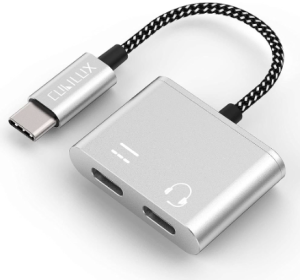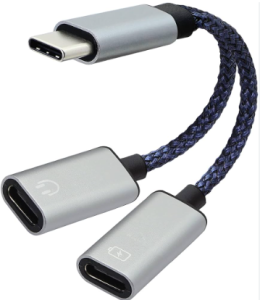USB C Splitter
In today’s fast-paced digital landscape, connectivity is paramount. Whether for work, entertainment, or communication, our devices need to seamlessly interact with one another. The advent of USB-C, a versatile and efficient connection standard, has revolutionized the way we connect our gadgets. As devices shed traditional ports in favor of USB-C, the demand for innovative solutions to connect multiple peripherals simultaneously has surged. This is where USB-C splitters come into play, offering a bridge between the past and the future of connectivity.
Understanding USB-C Splitters: A Bridge to Multifunctionality
USB-C, short for Universal Serial Bus Type-C, is a reversible, compact, and versatile connector that has rapidly become the standard for modern devices. With faster data transfer rates, higher power delivery capabilities, and compatibility across a wide array of devices, USB-C simplifies our digital lives. However, as we transition from older devices with diverse port options to newer models that prioritize USB-C, the need for a bridge between these worlds becomes evident. This is where the USB-C splitter shines.
A USB-C splitter, also known as a USB-C hub, is a device designed to multiply the functionality of a single USB-C port by providing multiple ports of various types. This allows users to connect a plethora of peripherals, such as external monitors, keyboards, mice, USB drives, and more, all through a single USB-C connection. The beauty of a USB-C splitter lies in its ability to offer a harmonious blend of old and new technologies, catering to both legacy USB-A connections and cutting-edge USB-C devices.
Key Features of the Best USB-C Splitters
Port Diversity: The hallmark of an excellent USB-C splitter is its range of ports. From USB-A and USB-C to HDMI, Ethernet, SD card slots, and audio jacks, the best splitters accommodate a variety of needs, ensuring compatibility with an array of devices. This versatility is particularly vital as users may require connections for work, entertainment, and personal use.

Data Transfer Speeds: USB-C’s true potential lies in its remarkable data transfer speeds. The best USB-C splitters leverage this capability, offering high-speed data transfer between connected devices. This ensures that files are exchanged swiftly and efficiently, enhancing productivity and user experience.
Power Delivery: Charging capabilities are a critical component of any USB-C splitter. The ability to deliver power to connected devices, such as laptops, tablets, and smartphones, is invaluable, particularly for users on the go. A high-power USB-C splitter can eliminate the need for multiple chargers, streamlining your workspace or travel setup.
Build Quality and Design: A USB-C splitter should be both durable and aesthetically pleasing. Premium materials, such as aluminum or high-quality plastic, contribute to the device’s longevity. Additionally, a compact and well-designed form factor ensures portability and ease of use.
Plug-and-Play Functionality: The best USB-C splitters prioritize user convenience. Plug-and-play functionality eliminates the need for intricate setups or driver installations. This seamless experience enhances user satisfaction and reduces potential compatibility issues.
Compatibility: As the technology landscape continues to evolve, maintaining compatibility across a range of devices is crucial. The best USB-C splitters offer wide-ranging compatibility with various operating systems, ensuring that users can connect their devices regardless of their brand or model.
Additional Features: Some USB-C splitters go the extra mile by offering features like 4K video output, Gigabit Ethernet for high-speed networking, and even built-in card readers. These additional features enhance the overall versatility and usefulness of the splitter.
The Best USB-C Splitters on the Market
Anker USB-C Hub: Known for its quality and reliability, Anker offers a range of USB-C splitters that deliver on all fronts. With a variety of port configurations, excellent data transfer speeds, and robust power delivery, Anker’s hubs cater to a wide range of user needs.
Satechi Multi-Port Adapter: Satechi’s USB-C splitters boast a sleek aluminum design and a host of ports, including USB-A, HDMI, and SD card slots. These splitters are particularly popular among MacBook users.

HyperDrive USB-C Hub: HyperDrive’s splitters are revered for their comprehensive range of ports, including unique options like an HDMI port that supports 4K 60Hz output. They also offer models specifically designed for certain laptops, ensuring seamless compatibility.
Dell USB-C Mobile Adapter: Dell’s splitter offers a minimalist design coupled with a practical selection of ports. It’s designed to complement Dell laptops and is an excellent choice for Dell users seeking consistency.
CalDigit USB-C Pro Dock: This advanced USB-C splitter is tailored for professional users who require extensive connectivity options. With features like dual 4K monitor support, high-speed Ethernet, and Thunderbolt 3 compatibility, it’s a powerhouse for productivity.
A Guide to Choosing the Best USB-C Splitter: Features and Considerations
USB-C splitters have become essential accessories for users who need to expand the connectivity options of their devices. Whether you want to connect multiple peripherals to your laptop, share content on different displays, or transfer data between devices, a USB-C splitter can be a valuable tool. However, with a wide range of options available, it’s important to know how to choose the best USB-C splitter that suits your needs. In this guide, we’ll explore key features and considerations to help you make an informed decision.
Compatibility:
Ensure the splitter is compatible with your devices and their operating systems. It should support USB-C specifications (USB 3.1 Gen 1/2 or USB 4) and work seamlessly with laptops, smartphones, tablets, and other USB-C enabled gadgets.
Number and Types of Ports:
Consider the number and types of ports you need. USB-C splitters come with various configurations, including USB-A, HDMI, DisplayPort, Ethernet, SD card readers, and more. Choose a splitter that provides the specific ports you require for your setup.
Power Delivery (PD) Support:
If you intend to charge your device while using the splitter, ensure it supports Power Delivery (PD). This feature enables higher power transfer, which is crucial for fast charging and supporting power-hungry devices.
Video Output:
For display-related tasks, such as connecting to external monitors or projectors, look for a USB-C splitter with video output capabilities. Check if it supports the desired resolution and refresh rate for your displays.
Data Transfer Speed:
If you plan to transfer large files frequently, opt for a splitter with USB 3.1 Gen 2 or USB 4 capabilities. These provide faster data transfer speeds, enhancing your overall productivity.
Build Quality and Durability:
Choose a splitter made from durable materials to ensure longevity. Aluminum or high-quality plastics are common choices. Also, check for reinforced connectors and strain relief features to prevent damage to cables.
Brand Reputation and Reviews:
Research reputable brands with a history of producing reliable accessories. Reading user reviews and expert opinions can provide insights into the real-world performance of the splitter you’re considering.
Compactness and Portability:
If you’re frequently on the go, consider the splitter’s size and portability. A compact design will make it easier to carry in your laptop bag or backpack.
Additional Features:
Some splitters offer extra features like hot-swapping support, which allows you to connect and disconnect devices without restarting your computer. Such features can enhance your overall user experience.
Budget:
Set a budget based on your requirements and the features you need. USB-C splitters come in a wide price range, so finding one that balances features and cost is important.
In Conclusion
As our devices continue to evolve, so do our connectivity needs. USB-C splitters bridge the gap between the past and the future, allowing us to seamlessly connect legacy and modern devices. With features like diverse port options, high-speed data transfer, power delivery, and compatibility across platforms, the best USB-C splitters enrich our digital experiences. Whether for work or leisure, these versatile devices enhance productivity, streamline setups, and ensure that our devices remain interconnected in an ever-expanding technological landscape.
FAQs about the Best USB-C Splitters
What is a USB-C splitter, and why might I need one?
A USB-C splitter is a device that allows you to expand a single USB-C port into multiple ports of various types, such as USB-A, HDMI, Ethernet, and more. This can be particularly useful for laptops or devices with limited USB-C ports, enabling you to connect multiple peripherals simultaneously, like external drives, monitors, and keyboards.
How do I choose the best USB-C splitter for my needs?
When selecting a USB-C splitter, consider the types and number of ports you require. Ensure compatibility with your devices and the intended peripherals, as well as the splitter’s data transfer and power delivery capabilities. Additionally, look for reputable brands known for producing reliable and durable products.
What features should I look for in the best USB-C splitter?
Look for features like 4K HDMI support for high-quality video output, USB 3.0 or 3.1 for fast data transfer, Power Delivery (PD) support to charge your laptop or device, Ethernet ports for wired network connectivity, and any other specific ports you need (USB-A, SD card, audio, etc.). The build quality, compactness, and ease of use are also important factors to consider.
Can I use a USB-C splitter with any device?
USB-C splitters are generally compatible with devices that have a USB-C port, but it’s essential to verify compatibility with your specific devices. Some older laptops or devices might not support all the features of a USB-C splitter. Also, ensure your device has the necessary software or drivers to enable all the functionalities of the splitter.
Are there any drawbacks to using a USB-C splitter?
While USB-C splitters are versatile, they do have some limitations. Sharing bandwidth among multiple ports might lead to reduced data transfer speeds when multiple peripherals are in use simultaneously. Additionally, not all USB-C splitters are created equal, so investing in a reputable brand with good reviews can help avoid potential reliability issues.
Remember that the “best” USB-C splitter depends on your individual needs, so thoroughly research different models and assess their features in relation to your usage requirements before making a purchase.
